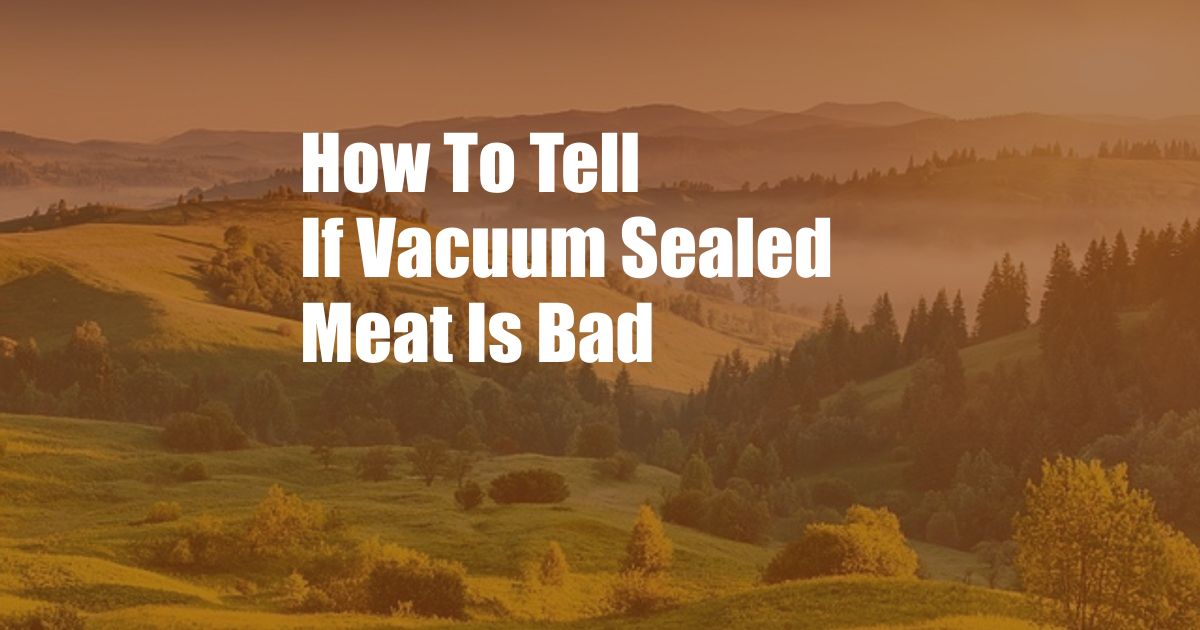
How to Tell if Vacuum Sealed Meat is Bad: A Comprehensive Guide
I vividly recall the day I cracked open a vacuum-sealed pack of ground beef, only to be greeted by a pungent odor and a slimy surface. That experience taught me the importance of knowing how to distinguish between fresh and spoiled vacuum-sealed meat.
Vacuum sealing is a fantastic method for preserving meat, extending its shelf life by removing oxygen from the packaging, preventing microbial growth. However, even vacuum-sealed meat can deteriorate over time. Here’s a comprehensive guide to assist you in determining whether your vacuum-sealed meat is still safe to consume.
The Telltale Signs of Spoiled Vacuum-Sealed Meat
Smell: Vacuum-sealed meat should have a mild, slightly metallic odor. If it smells sour, rancid, or putrid, it’s a clear indication of spoilage. Discard it immediately.
Texture: Fresh vacuum-sealed meat should be firm and slightly moist to the touch. Spoiled meat becomes slimy or sticky, and it may develop a layer of mold.
Color: Fresh red meat should retain its vibrant color even after vacuum sealing. If it turns brown or gray, it’s a sign of oxidation or spoilage.
Leaks or Swelling: Vacuum-sealed packages should maintain their airtight seal. Any leaks or swelling indicate bacterial growth or spoilage, rendering the meat unsafe for consumption.
Understanding Vacuum-Sealed Meat Shelf Life
The shelf life of vacuum-sealed meat varies depending on the type of meat, the storage temperature, and the packaging conditions. Here are some general guidelines:
Refrigerator:
- Ground beef: 1-2 days
- Steak, chops, roasts: 3-5 days
Freezer:
- Ground beef: 3-4 months
- Steak, chops, roasts: 6-12 months
It’s important to note that these are just estimates. Always check the package instructions or use your best judgment when assessing the meat’s freshness.
Tips and Expert Advice
Inspect the packaging: Before opening a vacuum-sealed package, carefully examine it for any holes, leaks, or swelling. Discard any damaged packaging.
Use within the recommended time frame: Adhere to the suggested storage time guidelines for vacuum-sealed meat. Consuming meat beyond its recommended shelf life increases the risk of foodborne illnesses.
Store properly: Vacuum-sealed meat should be stored in a clean, dry refrigerator or freezer. Avoid storing it near raw meat or other potential sources of contamination.
Thaw thoroughly: Before cooking, thaw vacuum-sealed meat completely in the refrigerator or under cold running water. Never thaw meat at room temperature.
Smell and taste test: After opening a vacuum-sealed package, always perform a smell and taste test to confirm the meat’s freshness. Discard any meat that has an off-odor or taste.
Frequently Asked Questions
Q: Can vacuum-sealed meat go bad?
A: Yes, vacuum-sealed meat can still spoil over time. While it extends the shelf life, it does not completely prevent spoilage.
Q: How long does vacuum-sealed meat last in the refrigerator?
A: Depending on the type of meat, vacuum-sealed meat can last in the refrigerator for up to 5 days.
Q: Is it safe to freeze vacuum-sealed meat?
A: Yes, vacuum-sealed meat can be safely frozen for extended periods. However, be sure to adhere to the recommended storage time guidelines.
Q: Can I re-vacuum-seal meat that has been opened?
A: No, it is not recommended to re-vacuum-seal meat that has been opened. This can create an ideal environment for bacterial growth.
Conclusion
Determining whether vacuum-sealed meat is bad requires a keen eye for detail and an understanding of spoilage indicators. By paying attention to smell, texture, color, and leaks, you can confidently identify spoiled meat and avoid potential foodborne illnesses.
Remember, vacuum-sealed meat is a valuable tool for preserving food, but it’s not a guarantee of indefinite freshness. Always check the meat carefully before consuming it and adhere to the recommended storage guidelines. By employing the tips and advice provided in this guide, you can enjoy vacuum-sealed meat with confidence and peace of mind.
Would you like to learn more about food preservation techniques? Explore our other blog posts for comprehensive insights and valuable tips.